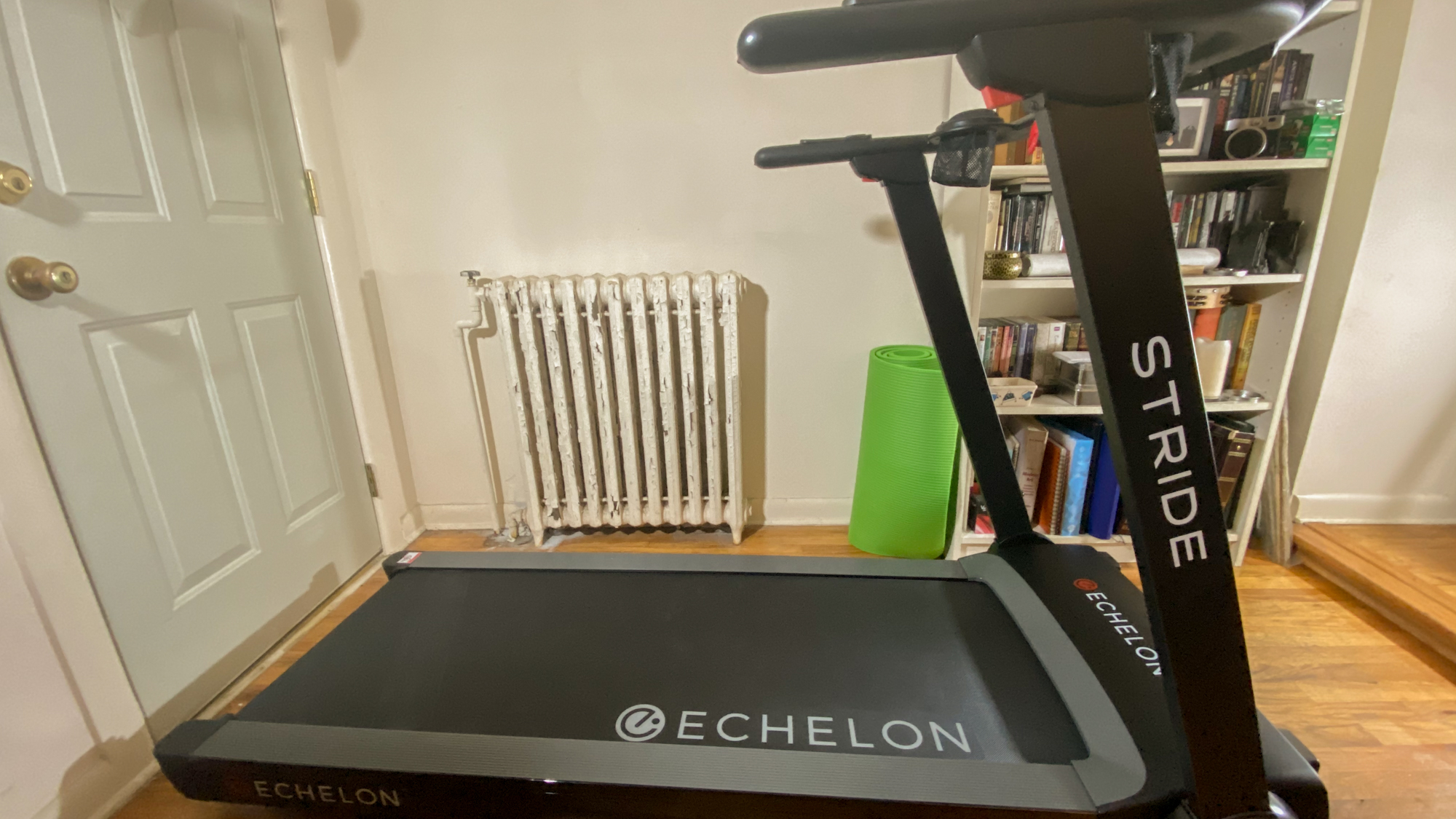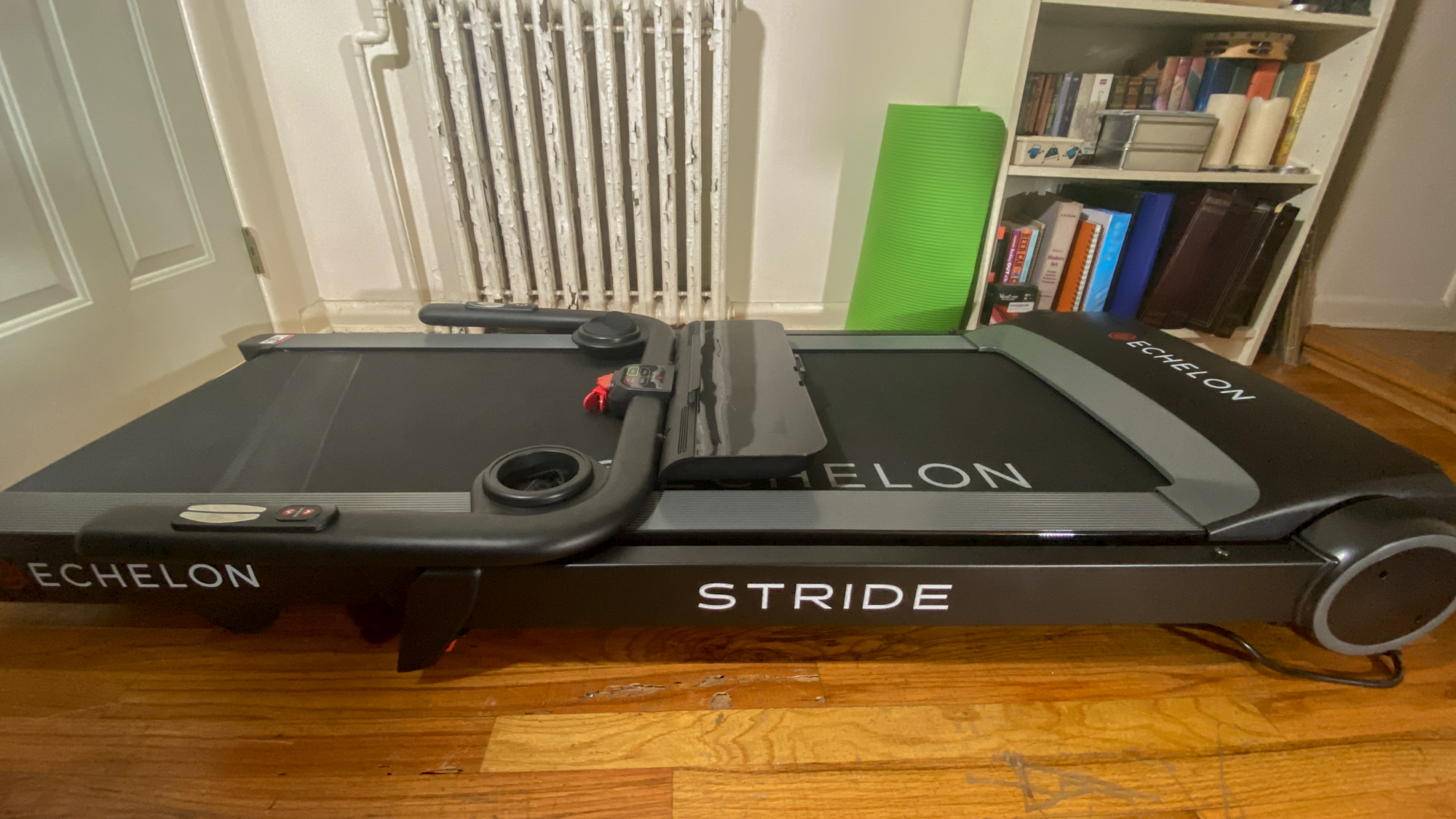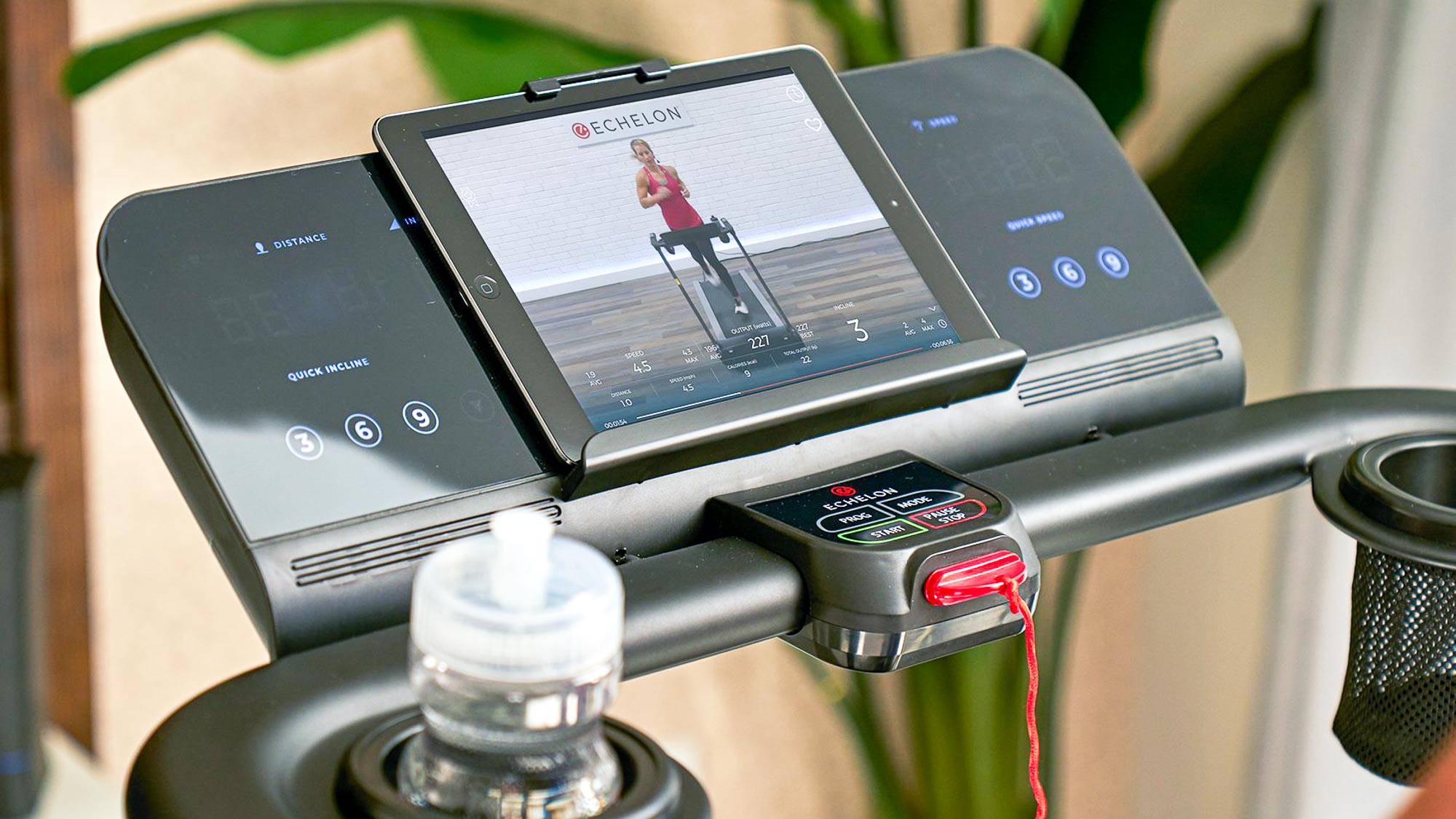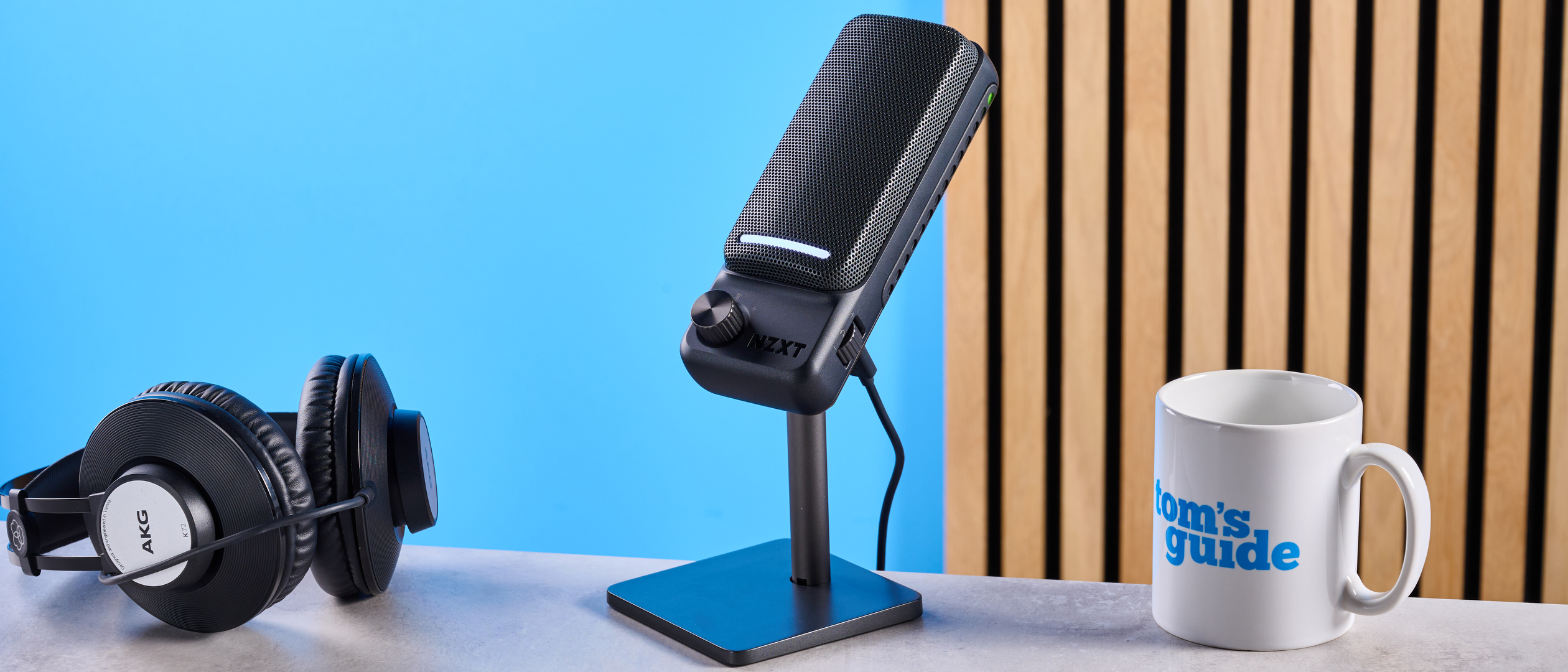Tom's Guide Verdict
The Echelon Stride is a good home treadmill that’s best for small spaces.
Pros
- +
Clever auto-folding system
- +
Compact and lightweight
- +
Works as standalone or with app
Cons
- -
Short running deck
- -
Weak motor
Why you can trust Tom's Guide
Dimensions (folded): 69.3 x 31 inches x 10.25 inches
Running surface: 55 × 20 inches
Weight: 156 lbs.
Max user weight: 300 lbs.
Motor: 1.75 HP
Max speed: 12 mph
Min speed: 0.5 mph
Incline: 12 levels
Max incline: 10%
Connectivity: Bluetooth
Note: This Echelon Stride review has been updated with new pricing and availability information.
Like many others, I’ve been looking for ways to stay fit while staying socially distant during the ongoing pandemic. With winter setting in, using the Echelon Stride treadmill is a more appealing alternative than taking walks or riding my bike outside.
The Stride is a newish model that straddles the line between budget folding treadmills and expensive, smart machines like the Peloton Tread.The Stride’s calling card is the auto-folding capability, which makes it easy to stow the treadmill and save on space. It lacks an HD screen, but can be paired with a tablet to access Echelon’s app filled with instructor-led classes. Read the rest of our Echelon Stride review for our take on its design, performance and features and to see how it stacks up against the best treadmills in the market.
Echelon Stride review: Price and availability
Depending on how you look at it, the Echelon Stride can be considered affordable or expensive. It’s the former if you want a Peloton alternative, since the Stride costs $1,339.98 — that includes the treadmill at $1,299.99, plus a free month of an Echelon United subscription. After the trial period, it’s $34.99, but you can cancel it if you don’t want access to live classes and instructors.
Meanwhile, the Peloton Tread starts at $2,495, not including the Peloton app’s $39 monthly subscription.
But the Echelon Stride’s price seems high compared to other top competitors, including the top pick on our list of best treadmills, the NordicTrack Commercial 1750. That treadmill is normally priced at $1,799 and comes with a 10-inch HD screen, a feature the Stride lacks.
The Echelon Stride is available for purchase on the Echelon website.
Echelon Stride review: Design
The Echelon Stride is stylish and sleek, though the track is a bit short at 55 inches. Most competitors in the Stride’s price range are 60 inches long. As a short person, I encountered no problems, but if you’re taller (more than 6 feet tall), you may need to adjust your stride when running.

The Stride is lightweight at just 156 pounds, compared to the Peloton Tread (450 pounds) and the NordicTrack (310 pounds). It can still bear up to 300 pounds, though.

So, it’s no tank. But it wasn’t meant to be. Its compact size and weight, plus the auto-folding mechanism, make it much more easy to stow than other treadmills.

The Echelon Stride doesn’t come with an HD screen, like the Tread or Commercial 1750. Instead, it has a digital touch console for when you’re using the Stride as a standalone treadmill. The display shows all the usual metrics — speed, distance, time, steps and heart rate — as well as several quick-select incline and speed buttons and eight pre-set workout options. The console has a tablet holder, which I used to place an iPad running the Echelon Fit app (more on that below). A USB port can be found on the backside of the console, so you can keep your device charged.
The arms have two cup holders for water bottles (and the Stride comes with an insert to hold a phone), as well as pulse monitors and buttons to increase/decrease speed and incline.
Echelon Stride review: Performance
I walked, jogged and ran on the Stride as both a regular treadmill and through classes on the Echelon app). While not as sturdy as heavier treadmills, the Echelon felt more stable than other, cheaper treadmills that were so flimsy, they felt like they’d probably break down in a few months. That said, I’m on the smaller side and a taller, heavier person might have issues with the Stride’s shorter running track and lightweight build.

The running deck was comfortable, though again, some people may have to change their stride length.
Everything about the Stride worked smoothly and efficiently. I was able to hop on and start warming up with a walk just by pressing a couple of buttons. Changing speed and incline was a breeze with the armrest buttons. When used as a regular treadmill, the Stride has similar functionality to any gym machine. I could create my own workout or choose one of the eight pre-sets.
Aside from the shorter deck, the only major strike against the Stride is the relatively weak 1.75 horsepower motor. Compare that to the similarly-priced NordicTrack T 6.5 Si, which has a 2.6-HP motor. The Stride is capable of reaching a top speed of 12 mph, but with such a weak motor, the treadmill is more suited for light jogging and walking more than hard running.
Echelon Stride review: Features
The Stride’s best feature is the auto-folding process, which makes storage a snap. When you have a small space, like I do, that’s a real blessing. To fold the Stride, all you do is push down the arms and console, then step on a lever and the arms automatically lower down to the track. When it’s folded, it measures just 10 inches thick. The treadmill can slide underneath furniture, or be raised to a vertical position and wheeled against a wall.

The Stride doesn’t have an HD screen, which I suppose cuts down on the price. Then again, the NordicTrack T 6.5 Si costs about the same ($1,299) and comes with a 10-inch display. If you don’t care about classes or scenic views, then a screen isn’t necessary. And in the Stride’s case, you can use your own tablet to access the Echelon app.
Echelon Stride review: App
Purchasing the Stride requires you to sign up for an Echelon membership. If you’re not interested in the live or on-demand classes, then you can just select the monthly plan and cancel after the month is up. The Stride works perfectly well as a standalone treadmill.

That said, if you’re looking for a cheaper Peloton alternative, then the Stride plus the Echelon Fit app mostly fits the bill. Just like the Peloton app, Echelon Fit features classes taught by instructors. Unlike Peloton, Echelon’s app isn’t synched to the Stride, so you have to manually change pace and incline.

All of the instructors are peppy and personable and they play current music and past hits. The rhythm runs are tied to different genres, like pop, rock and hip hop. The classes range from warm ups and cool downs to timed walks (10-30 minutes), hill sprints, and endurance runs. One instructor even held a Turkey Trot 5K. And just like the Peloton app, you can see other users and even track your progress against the community.

Personally, I like more chill workouts, so I mostly enjoyed the scenic options, like the 30-minute coastal seaside run and the 20-minute Spain nature run.
Echelon Stride review: Verdict
The Echelon Stride is somewhat odd for a treadmill — not cheap, nor high-end. In most categories, it’s just fine in terms of build, power and features. The Stride has fewer bells and whistles than more expensive treadmills, yet it also boasts an easy-to-use folding mechanism and slim profile that makes it eminently storable.
Yes, the Stride is a bit strange and doesn’t quite fit into any treadmill category. It isn’t a flimsy folding treadmill that you expect to wear out in a year. But, with its weak motor and lack of a built in display, it isn’t a true Peloton competitor, either. Yet, the Stride mixes mostly the good parts of both. If you’re looking for a fairly affordable yet durable and compact treadmill that syncs with instructor-led workouts, then the Stride is a good option.
- Peloton vs. Echelon: Which exercise bike is best for you?

Kelly is the managing editor of streaming for Tom’s Guide, so basically, she watches TV for a living. Previously, she was a freelance entertainment writer for Yahoo, Vulture, TV Guide and other outlets. When she’s not watching TV and movies for work, she’s watching them for fun, seeing live music, writing songs, knitting and gardening.

